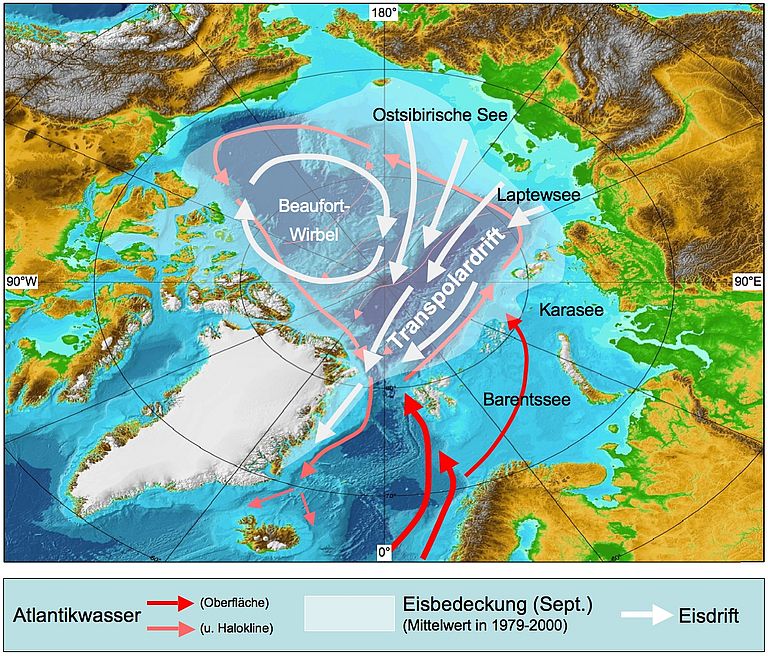On the Trail of Climate Change in the Arctic
New German-Russian research project starts with the first expeditions to the Arctic Ocean
The ecosystems in the Arctic are on thin ice – quite literally. Not only is the ice-covered area in the Arctic Ocean during the summer months diminishing from year to year, the thickness of the ice is also decreasing measurably. Thus, the volume of ice in the Arctic has shrunk over the past 30 years by about 75 percent. “These changes are particularly evident in the area of the transpolar drift which transports ice from the Siberian shores across the North Pole to the Fram Strait between Svalbard and Greenland,” says Dr. Heidemarie Kassens from GEOMAR Helmholtz Centre for Ocean Research Kiel. Therefore, a new German-Russian research project entitled “System Laptev Sea - The transpolar system of the Arctic Ocean” will investigate the large scale changes in the Arctic and the implications for Europe. The Federal Ministry of Education and Research (BMBF), the Russian Ministry of Education and Research, the Alfred Wegener Institute Helmholtz Centre for Polar and Marine Research (AWI) and the GEOMAR will finance the project until 2016 at about 7 million euro. A total of 15 expeditions are planned in the area of the transpolar drift. Last week the first expedition into the Laptev Sea, East Siberia, has been launched. Along with 19 other scientists from Germany and Russia, project coordinator Dr. Kassens will deploy ocean observing stations from the Russian research vessel VIKTOR BUYNITSKIY to accurately measure these changes over the course of one year, and also to make oceanographic, marine chemical and biological measurements.
The project builds on many years of joint German-Russian research where scientists of many different disciplines worked together. The goal is to capture the full extent of change in the Arctic. Because the warming of the Arctic not only leads to loss of ice, but also has consequences for the chemistry and physics of the Arctic sea-water, for the atmosphere, and for the polar habitat.
“The near-surface waters are warmer and less salty than they were a few years ago. More and more species migrate from the Atlantic into the Arctic Ocean, while ocean acidification takes place at the same time. All of these changes have an impact on this sensitive habitat which we cannot yet foresee,” explains Dr. Kassens who has regularly led expeditions into the Laptev Sea in recent years.
During this expedition with the official title TRANSDRIFT XXI, a total of five stations are to be anchored in the Laptev Sea. They are equipped, among others, with new automatic water samplers. “For one year, they will take one water sample per week. This will allow us to track the physical changes of water masses throughout all seasons,” explains Dr. Jens Hölemann of AWI.
While the expedition TRANSDRIFT XXI heads to the origin of the transpolar drift off the coast of eastern Siberia, other scientists will be working in its terminus region around Spitsbergen at the same time. On the AWI-coordinated expedition MSM31 with the German research vessel MARIA S. MERIAN, Dr. Robert Spielhagen (GEOMAR / Academy of Sciences and Literature in Mainz), among others, has embarked to retrieve high-resolution sediment cores from the sea floor north of Spitsbergen. “This allows us to trace back the development of the ice cover and the environmental conditions at the end of the transpolar drift over thousands of years,” explains the paleo oceanographer.
“This expedition allows us to connect the Laptev Sea as an important area for sea ice formation on the one hand to the Fram Strait as the only deep water connection between the Arctic Ocean and the Atlantic Ocean on the other hand,” says project coordinator Dr. Kassens. “The Arctic seems to be far away, but changes in the atmosphere and the ocean currents at those locations also affect the climate and the environmental conditions here in Europe. All the more is it important to understand these changes and their consequences.”
Project partners:
o GEOMAR Helmholtz Centre for Ocean Research Kiel (Germany coordination)
o National Institute of Arctic and Antarctic Research Institute (AARI), St. Petersburg, Russia (Coordination Russia)
o Alfred Wegener Institute Helmholtz Centre for Polar and Marine Research
o Academy of Sciences and Literature Mainz
o University of Trier
o Christian-Albrechts-University of Kiel
o Moscow University
o PP Shirshov Institute of Oceanology Moscow
o Lena Delta Reserve Tiksi
o State NN Zubov Institute of Oceanography (GOIN).
Images in higher resolution:
The transpolardrift connects the Arctic shelf seas with the Fram Strait between Svalbard and Greenland. German and Russian researchers intend to jointly investigate the effects of climate change on this system. Graphics: GEOMAR
The Russian research vessel VIKTOR BUYNITSKIY. For a little more than a month, German and Russian scientists will use it to deploy observation stations in the East Siberian Laptev Sea. Photo: H.Kassens, GEOMAR
The German research vessel MARIA. S. MERIAN is currently working off Spitsbergen. Expedition MSM31 also contributes to the "Transpolar Drift" project. Photo: JAGOT eam, GEOMAR.
Contact:
Jan Steffen (GEOMAR, Communication & Media), Tel.: (+49) 0431 600-2811, jsteffen(at)geomar.de





